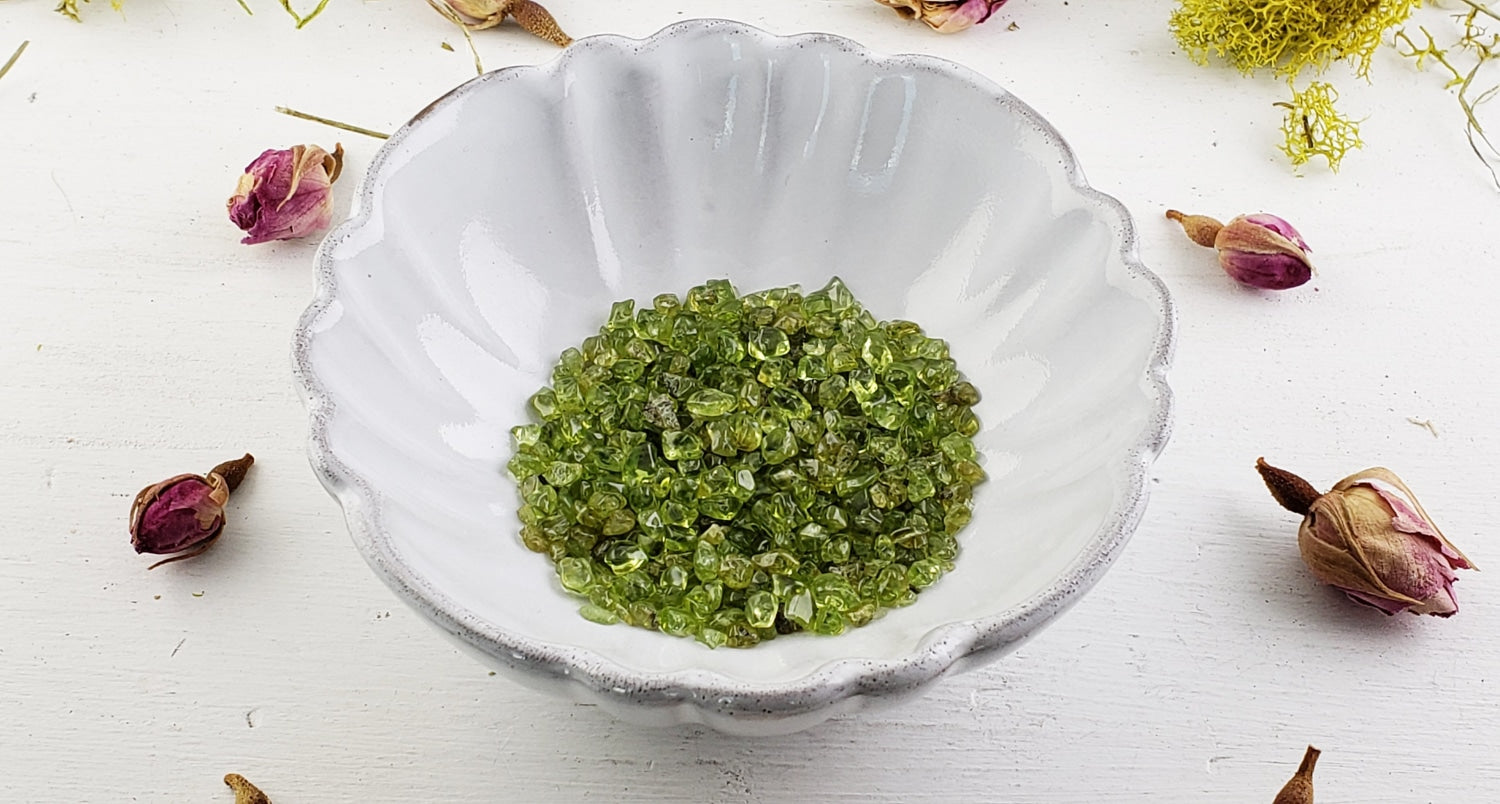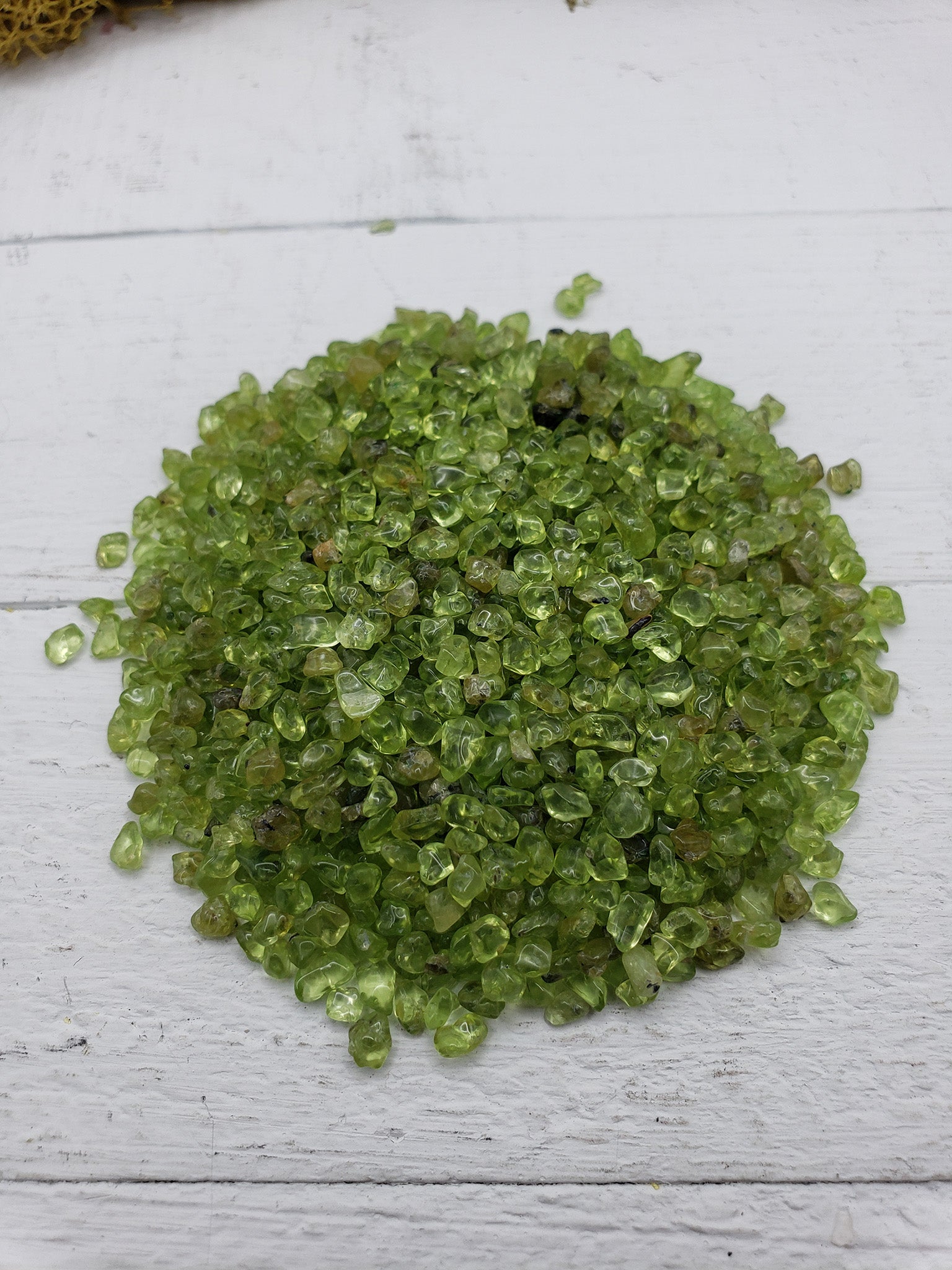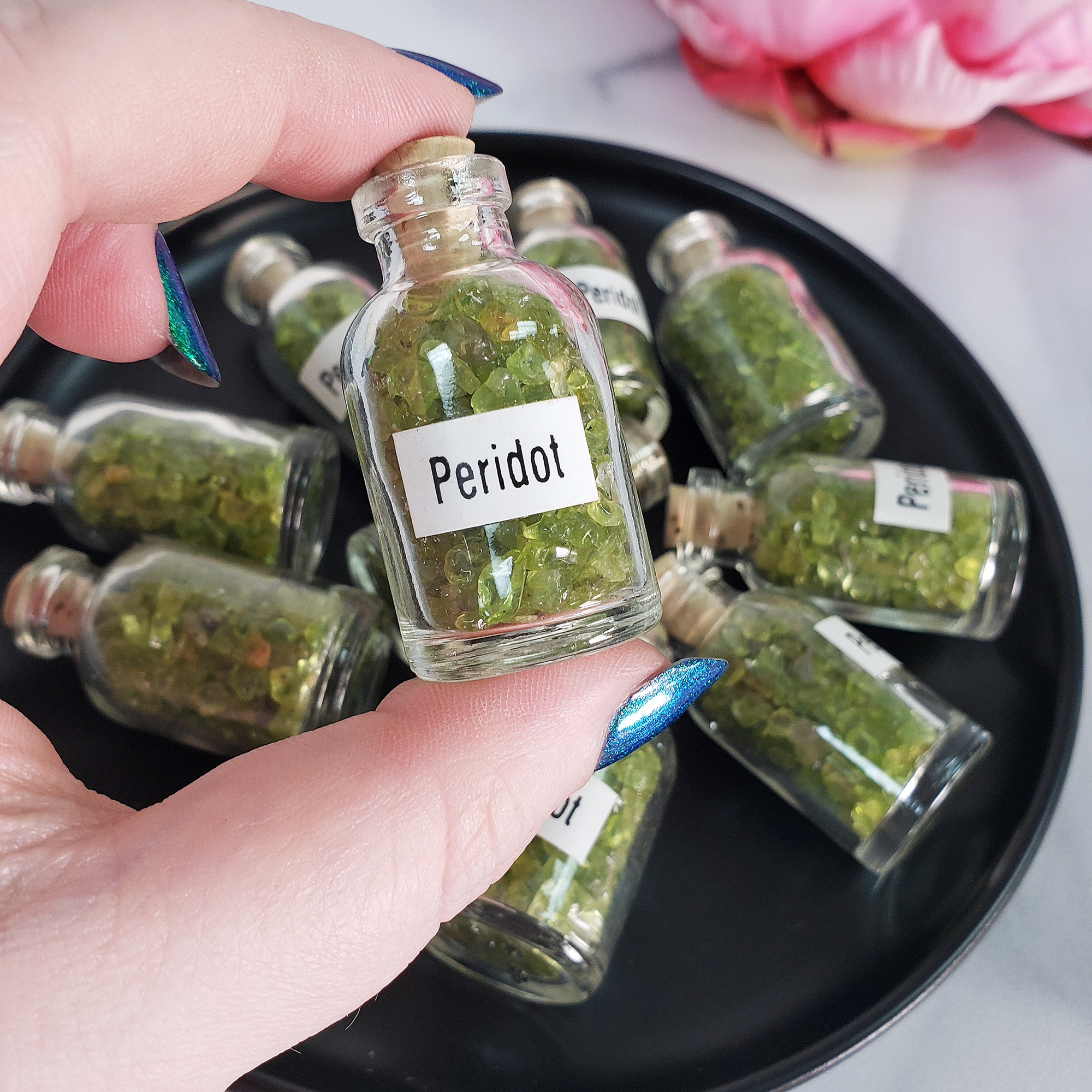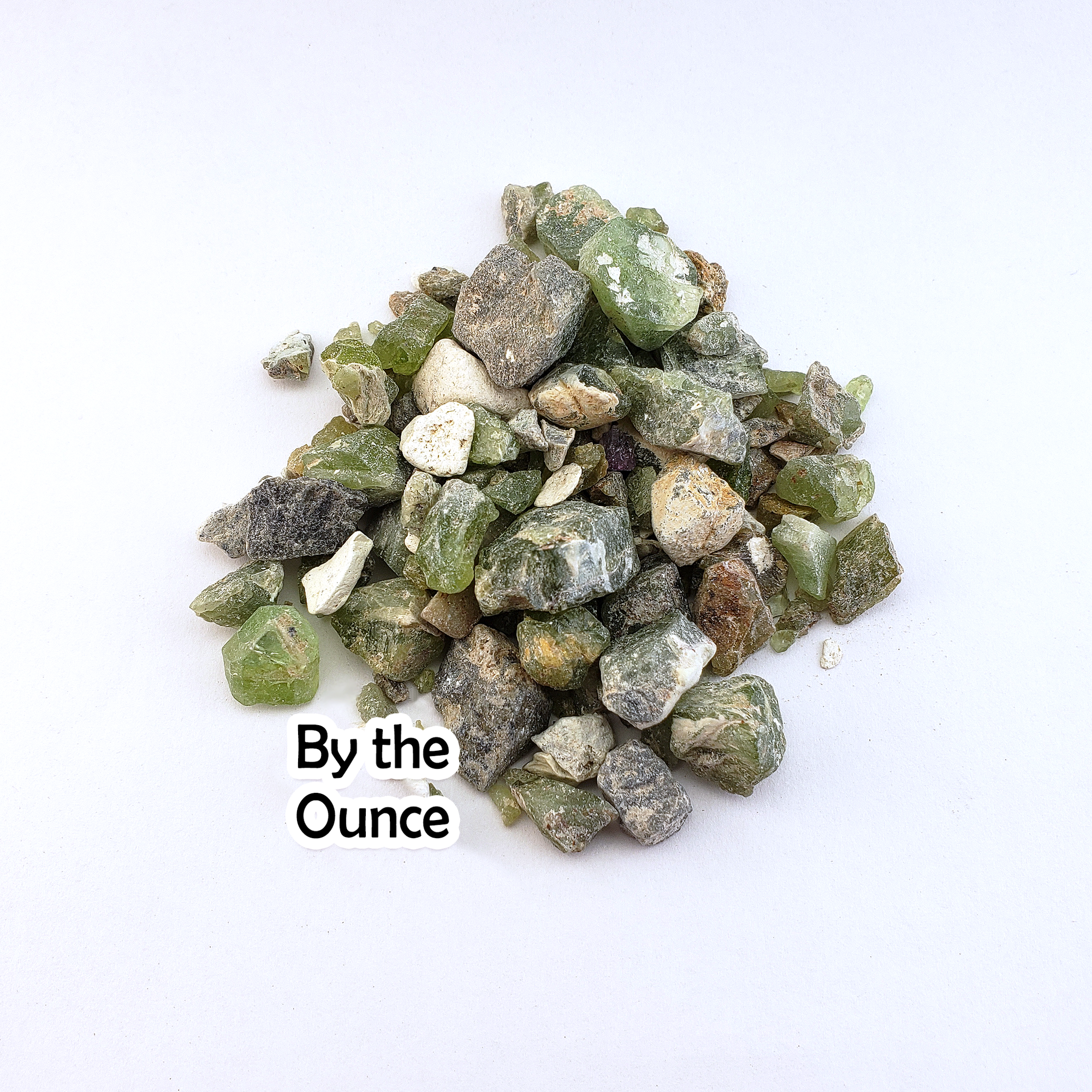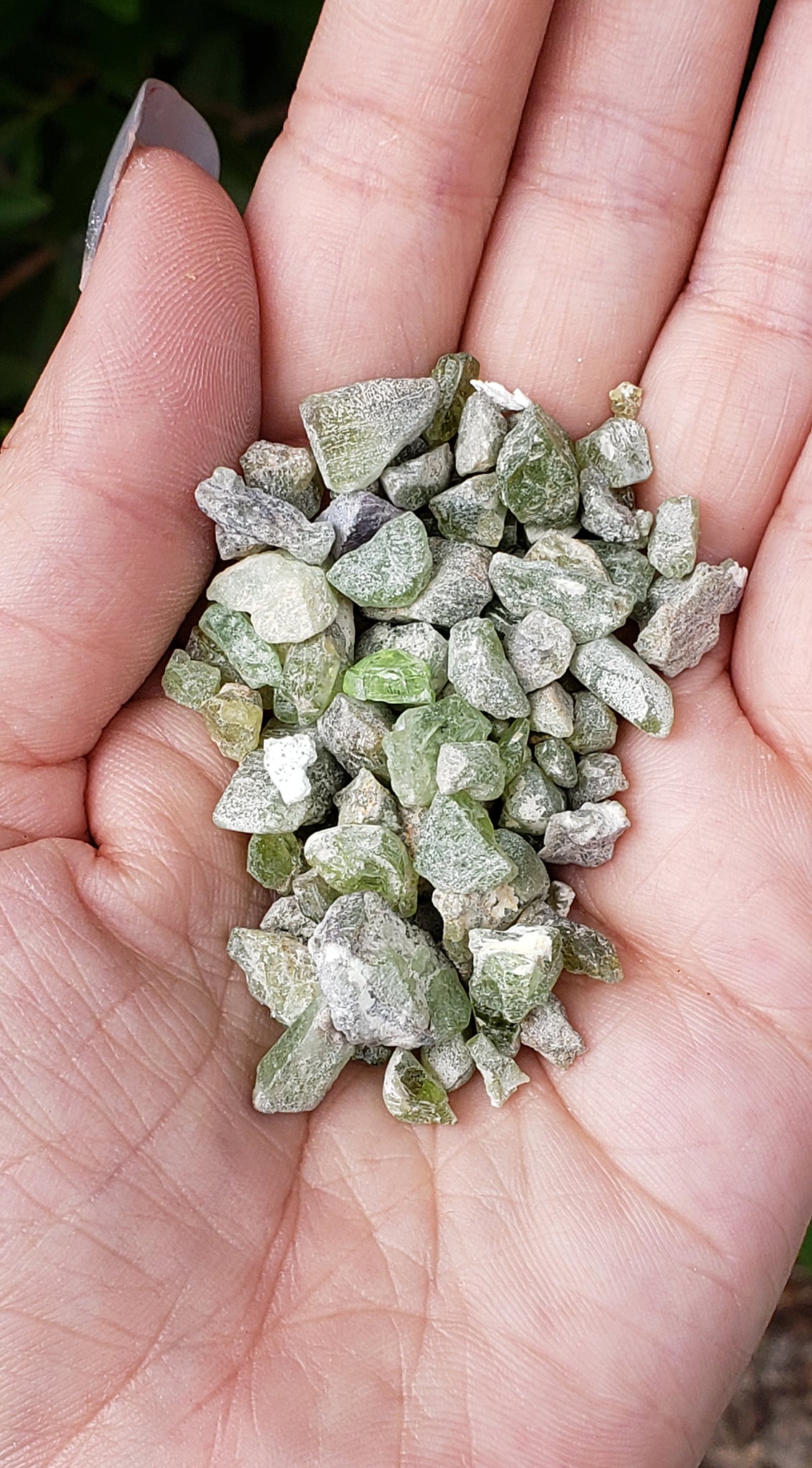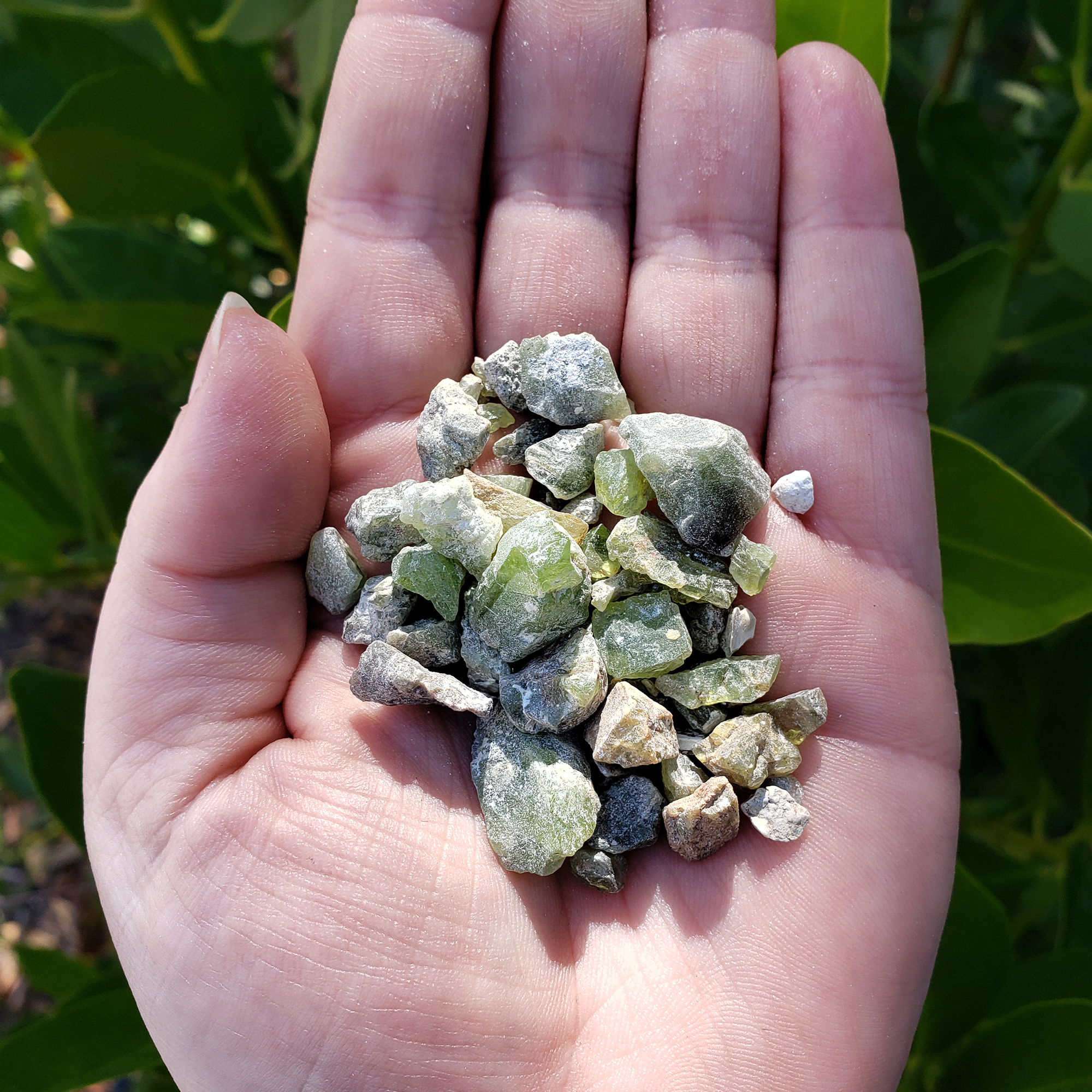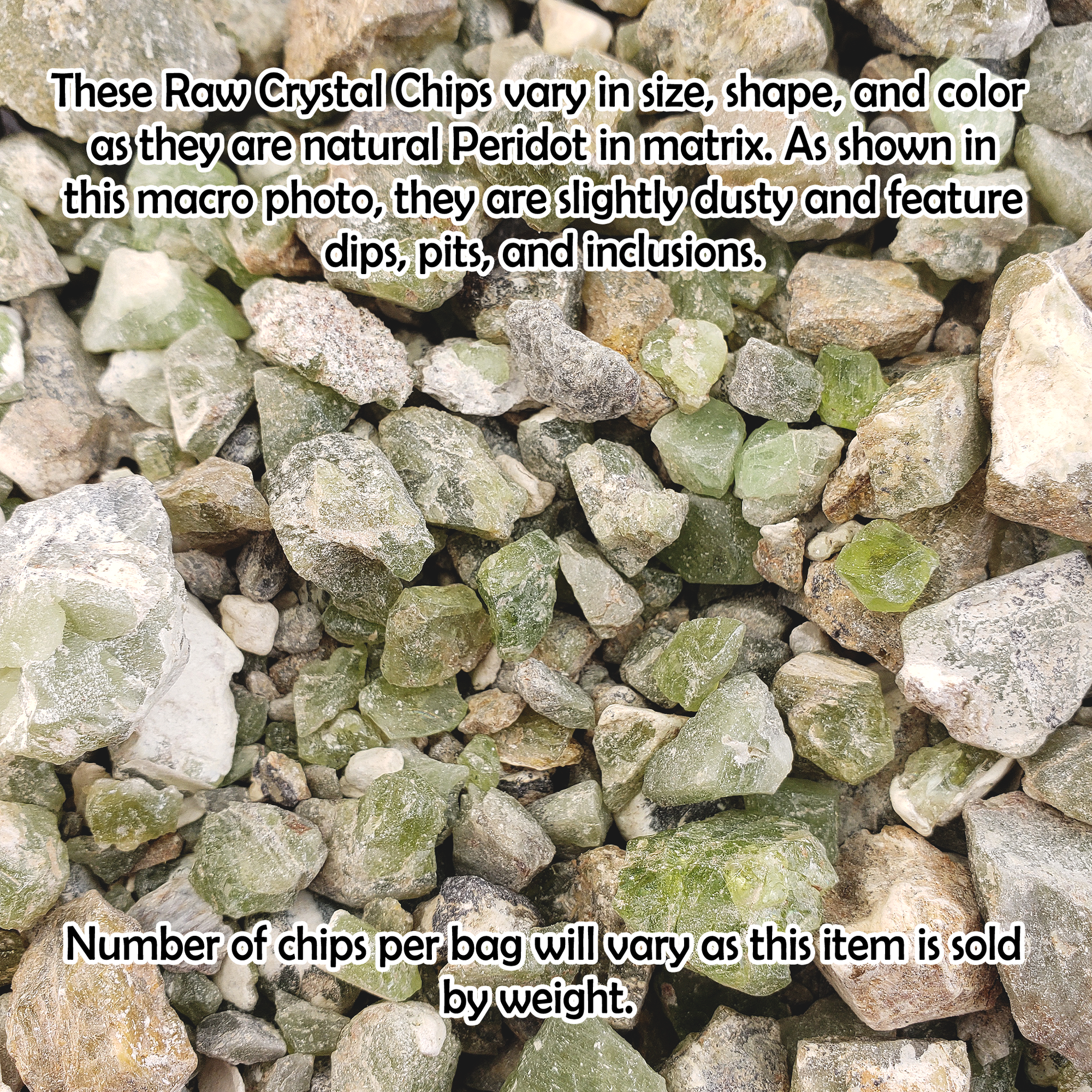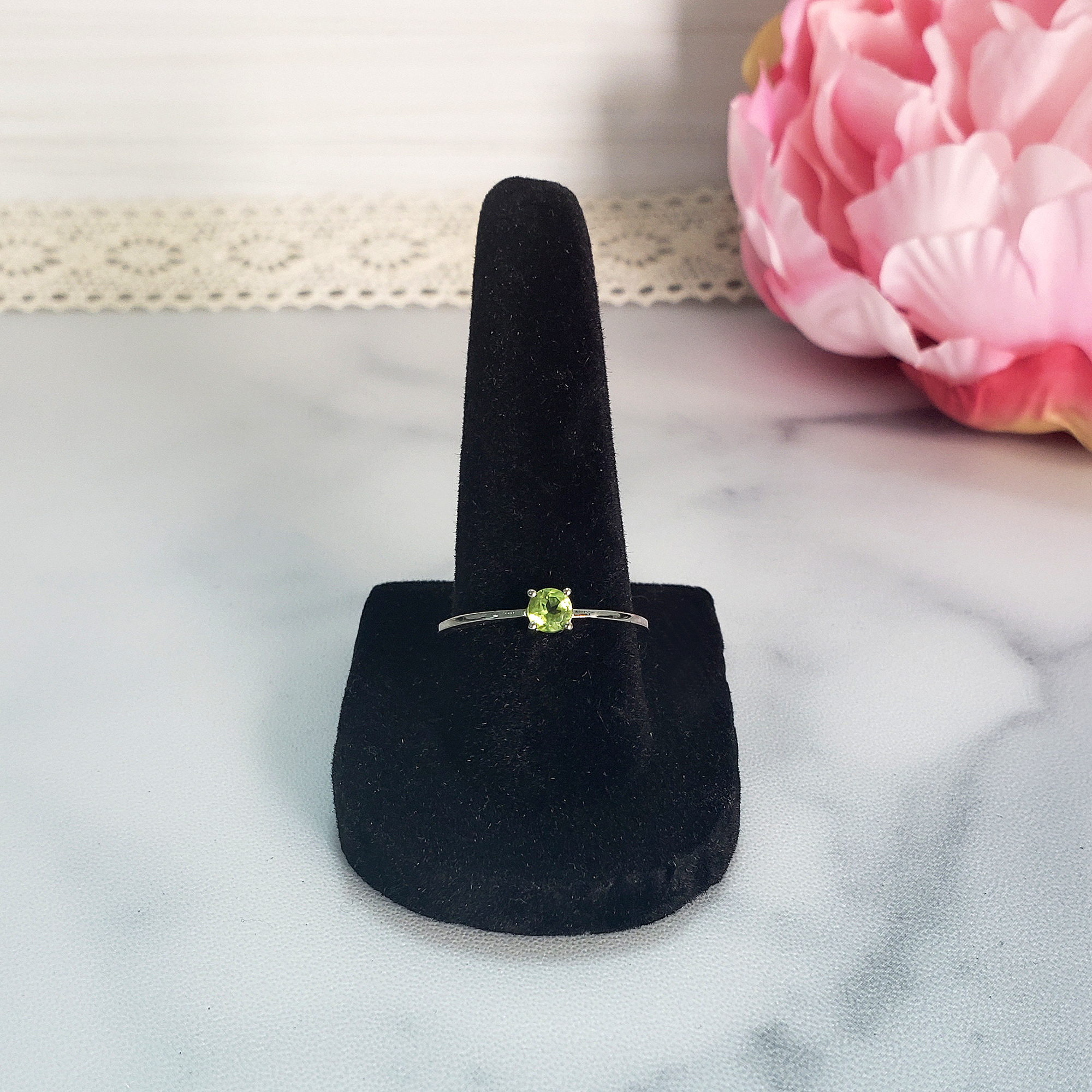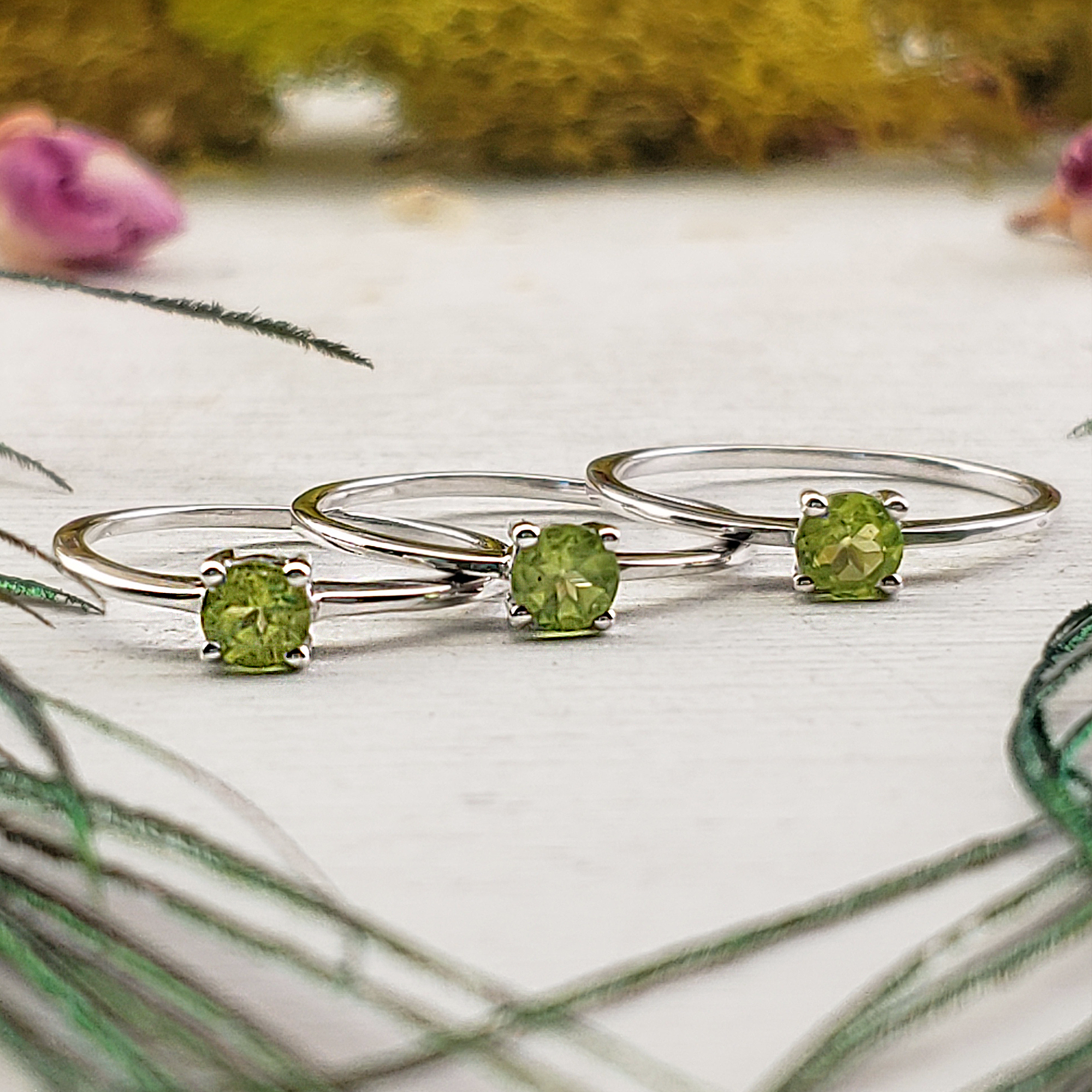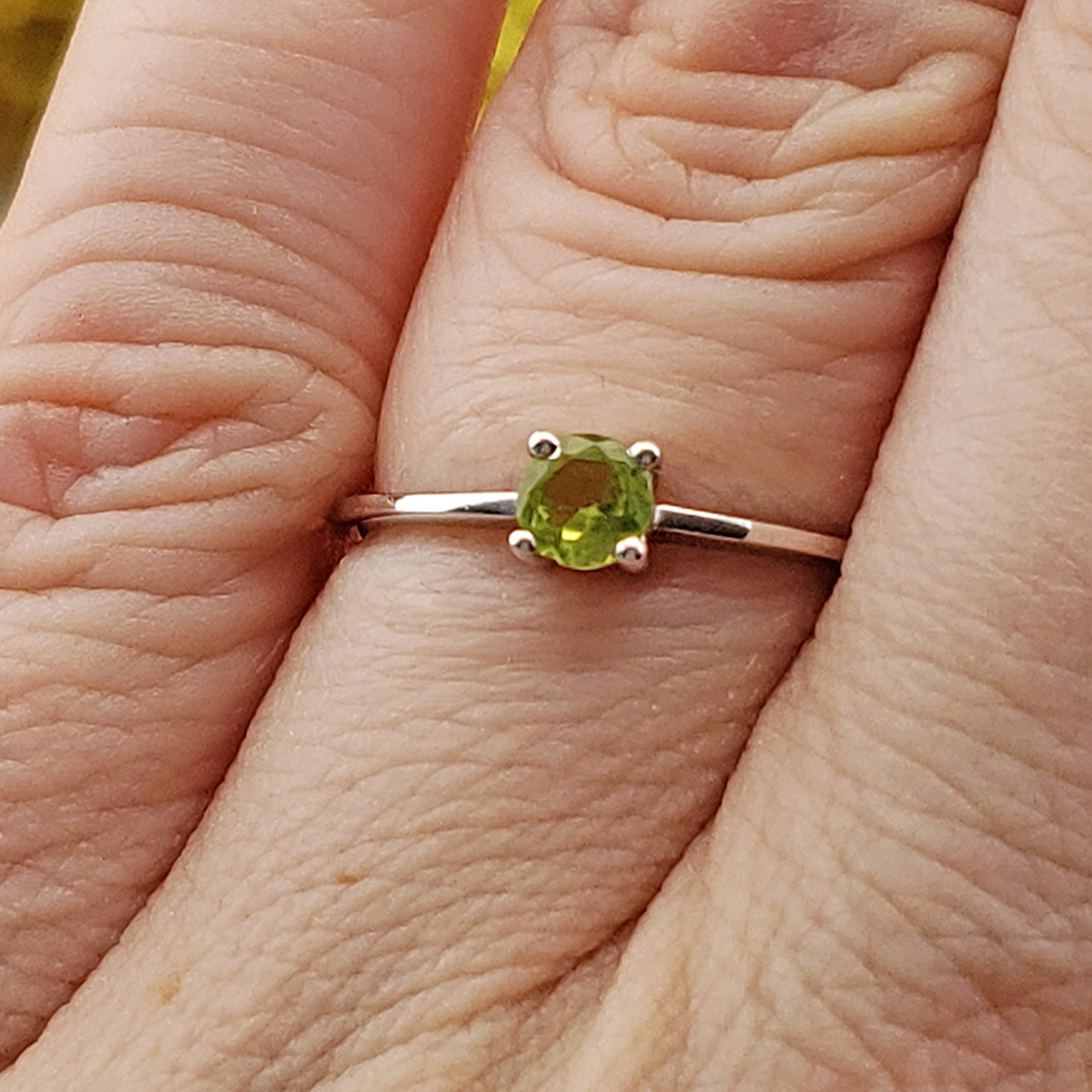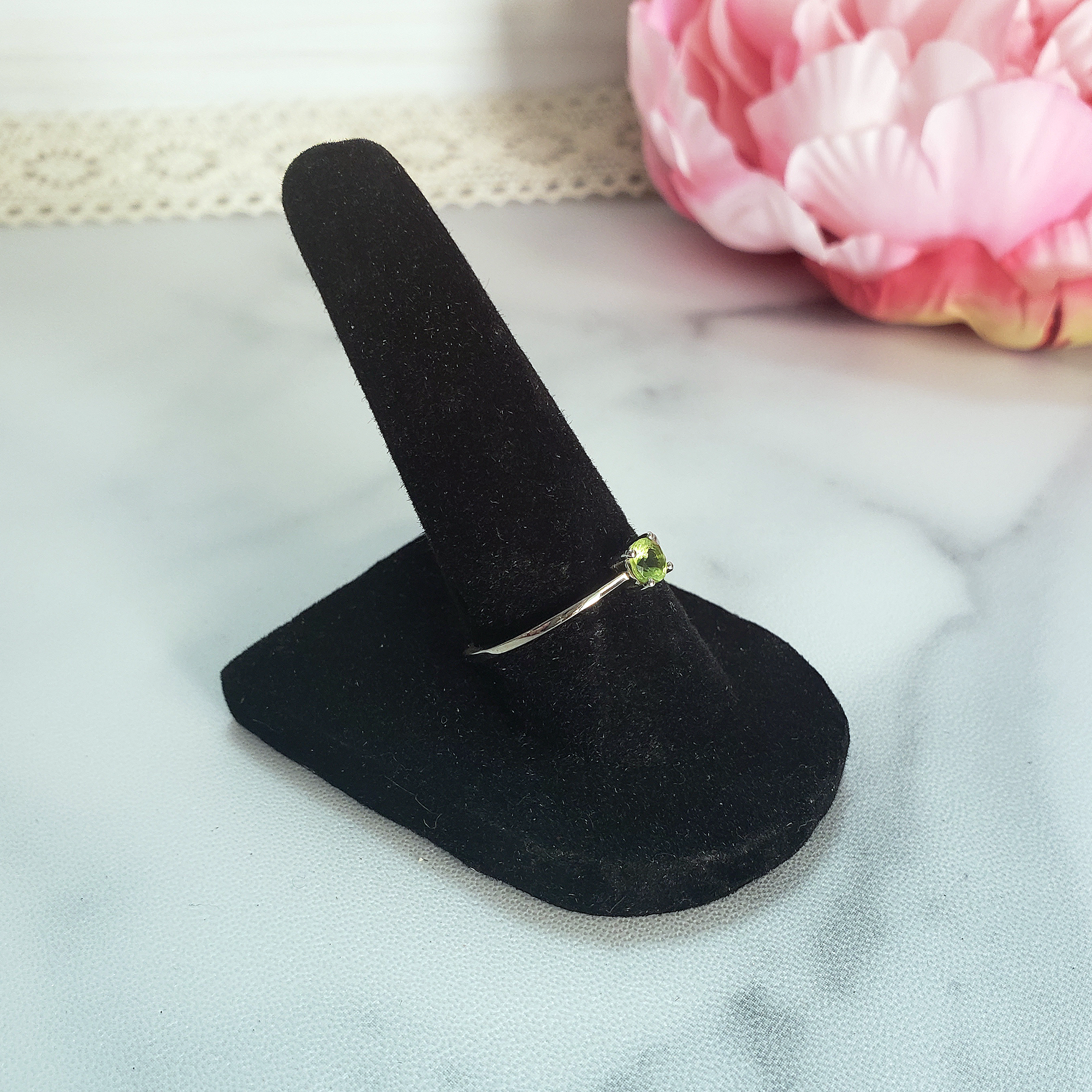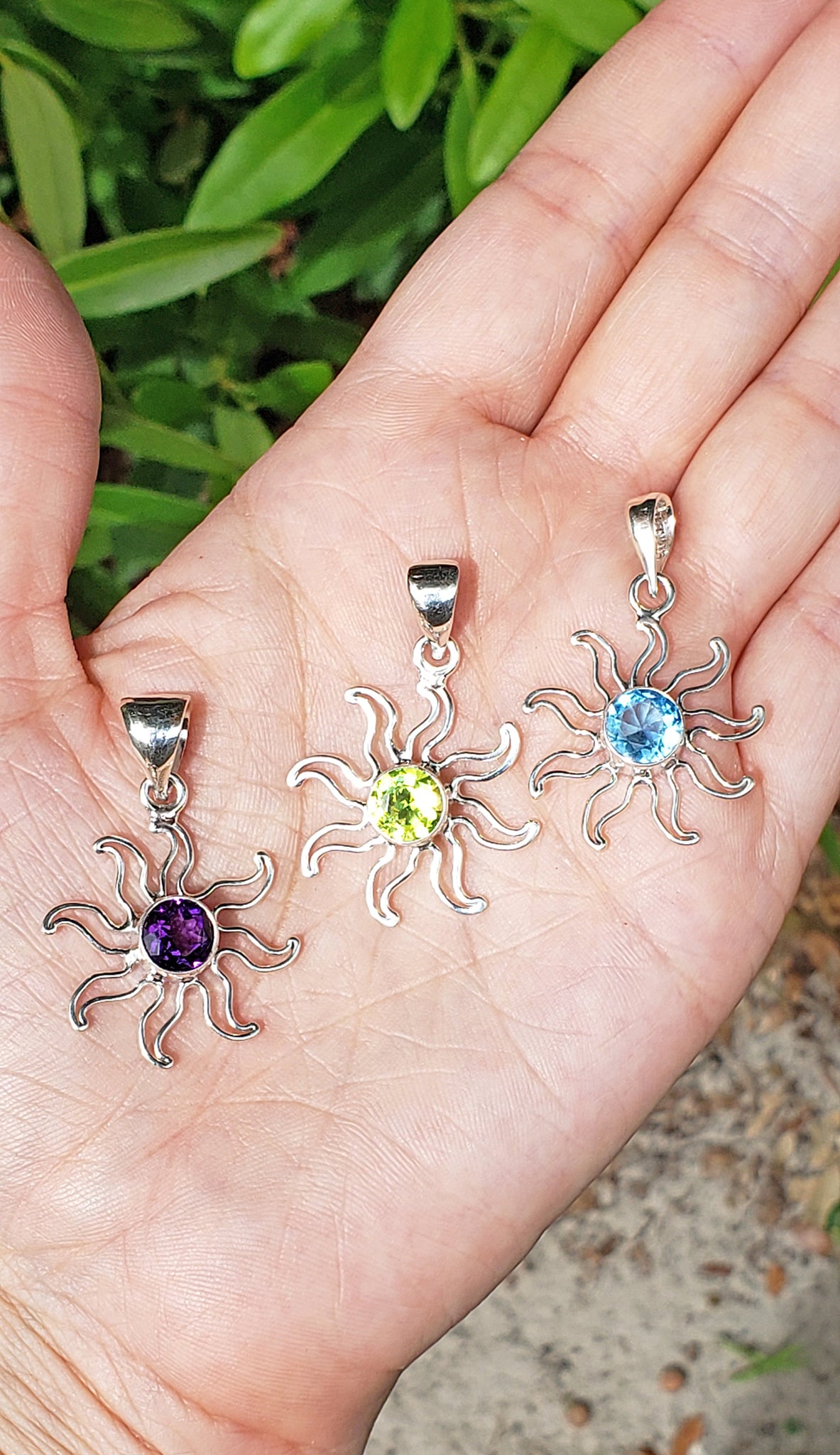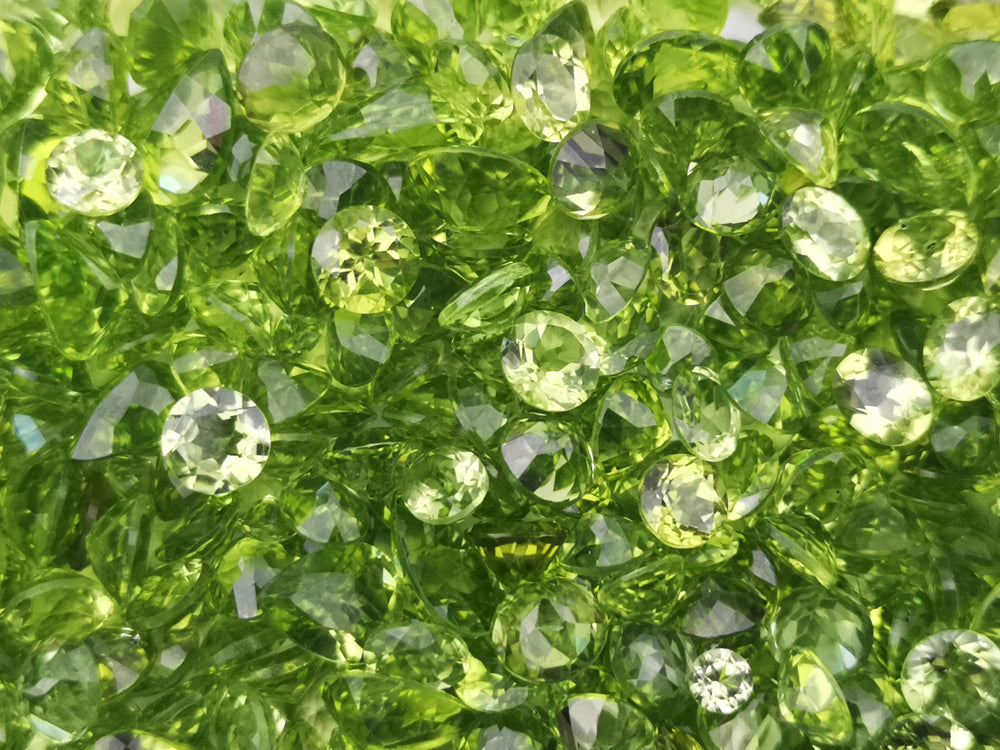What is Peridot?
Peridot is a natural gemstone variety of Forsterite, a member of the Olivine group. Sometimes called Night Emerald, Evening Emerald, Noble Olivine, or Peridote, Peridot is a gem known for its vibrant yellow-green tones. It can be found in nodules, pockets, or lining veins within solidified molten rock. Indeed, Peridot's associations with the Fire Element are likely due to the gemstone being found in places where lava flows have pushed up to the surface, and it is often found within Basalt, a volcanic rock.
The green color of peridot ranges from yellowish green to greenish yellow, creating a captivating visual appeal. This particular shade of green is significant because it reminds us of the lushness of lawns, the vitality of trees, and the tranquility of nature. Human beings naturally gravitate towards this color, drawn by its soothing and refreshing qualities.
As a result, this green hue not only defines peridot's beauty but also contributes to its popularity. It's a color that connects us to the earth, evoking a sense of peace and natural allure. Whether set in jewelry or simply admired in its raw form, the green of peridot holds a unique place in the world of gemstones.
Key Physical Properties of Peridot
- Mineral: Olivine
- Chemistry: (MgFe)₂SiO₄
- Color: Yellowish green
- Refractive index: 1.65 to 1.69
- Birefringence: 0.035 to 0.038
- Specific gravity: 3.34
- Mohs Hardness: 6.5 to 7
These technical characteristics are what define peridot's unique physical presence in the world of gemstones. The refractive index and birefringence contribute to its sparkling beauty, while its specific gravity and hardness ensure durability, making it a cherished choice for various types of jewelry.
Some sources have also found Peridot within meteorites that have crashed to Earth! This remarkable fact is why peridot is often considered an "extraterrestrial" gem. These peridot crystals are not only otherworldly but also incredibly rare, with some large enough to be faceted into stunning cut gemstones.
Peridot has been treasured throughout history and was spoken of by Pliny all the way back in 70 AD. This historical reverence is only amplified by its cosmic origins, making peridot a gem that is both historically significant and universally fascinating.
The allure of peridot lies in its dual identity—rooted in the Earth's history and reaching into the mysteries of space.
How to Pronounce Peridot?
There is some controversy over the pronunciation of this gemstone's name. It's likely that you will pronounce it Pair-a-doh. This is because, etymologically speaking, the word Peridot comes from the Old French "Peritot". In French, the final t is typically silent. However, in English-speaking countries where this silent t rule is not habitual, the word Peridot is usually pronounced Pair-uh-dot. In fact, this English pronunciation was used as a character name in an extremely well loved animated series! Although there is much debate about the right way to say Peridot, both pronunciations are widely accepted. In our opinion, that means that both are correct, but Bee will always pronounce it Pair-a-doh.
What Birthstone is Peridot?
The Peridot gem is a birthstone for the month of August. This is quite fitting, since the primary Zodiac sign for August is Leo, whose season ranges from July 23 to August 22. Both the Peridot stone and the Zodiac sign Leo are associated with the Sun and the Fire Element. Virgos born at the very end of August can also benefit from the uplifting, cleansing energy of the Peridot gemstone.
In addition to its role as a birthstone, peridot is also significant as the traditional gemstone for the 15th anniversary. This dual significance highlights its enduring appeal and the belief in its positive energies, making it a cherished choice for both personal milestones and celebratory occasions.
Where is Peridot Found, Sourced, and Mined?
Peridot, a captivating gemstone, has been extracted from various locales worldwide, transcending its historical origins by the Red Sea. Today, it can be found in several countries, including Myanmar, China, Vietnam, the United States, and Tanzania.
However, one of the standout sources is Pakistan. The peridot mined in Pakistan, particularly from the mountainous region of the Kohistan Range, is prized for its exceptional clarity and vibrant green hue. This unparalleled quality and lustrous shine make Pakistani peridot highly coveted among gem collectors and jewelry enthusiasts alike.
Origins and Characteristics of the Exceptional Peridot Crystal from Myanmar
The Origins
This remarkable peridot crystal hails from the rich mineral deposits of Myanmar, a region renowned for its high-quality gemstones. Nestled within the geological formations of this Southeast Asian country, the peridot is mined with care to preserve its natural beauty.
The Characteristics
- Size and Form: The crystal stands at an impressive 4.3 centimeters in height, showcasing the size often sought after by collectors.
- Color and Clarity: Known for its vibrant green hue, this peridot exhibits clear, vivid coloring that captures the eye and reflects light beautifully.
- Rarity: Myanmar peridots are among the finest in the world due to their exceptional clarity and intensity of color, making this crystal a rare find for connoisseurs.
- Cut and Finish: Skillfully crafted to enhance its natural allure, the crystal's cut reveals the stunning internal structure characteristic of top-grade peridot.
These qualities make the Myanmar peridot crystal not only a gem of geological interest but also a prized possession for gemstone enthusiasts and collectors.
What Does "Eye Clean" Mean for Peridot Stones?
When you hear the term "eye clean" used in the context of peridot gemstones, it's referring to a high standard of clarity. Essentially, an "eye clean" peridot is free from inclusions or blemishes when viewed with the naked eye, under normal lighting conditions. This means there are no visible imperfections disrupting its brilliance or color.
Why is this Important?
-
Aesthetic Appeal: An "eye clean" peridot boasts a clear, vibrant appearance that enhances its overall visual appeal. Without visible inclusions, the gemstone can display its natural, rich green hues more vividly.
-
Value: In the gem world, clarity contributes significantly to the stone's value. Peridots that are devoid of visible flaws are often more desirable and command higher prices in the market.
-
Jewelry Versatility: Due to their clean appearance, these stones are ideal for various jewelry settings, from elegant necklaces to striking rings, allowing designers creative flexibility.
How to Identify an Eye Clean Peridot
-
Examine Under Natural Light: Hold the gemstone against a light source. If you cannot detect any internal imperfections with your naked eye, it's likely "eye clean."
-
Consult a Gem Expert: For assurance, consider having the peridot evaluated by a professional jeweler who can confirm its clarity status.
An "eye clean" peridot represents both a visual and financial advantage, making it a prized choice for jewelry enthusiasts and collectors alike.
Peridot Meaning and Metaphysical Properties
Peridot is a versatile crystal and a spiritual powerhouse, known for its associations with solar energy, purification, forward momentum, and metaphysical protection. Resonating intensely with the Solar Plexus Chakra, the Peridot gemstone is known for promoting a future-focused mindset that encourages us to let go of fears, obsessions, and negative influences. Awakening a fiery burst of courage, Peridot is used as a stone of protection, particularly when it comes to shielding against outside interference, doubts, and resentments. Peridot jewelry is worn by those who seek to cleanse away negativity, instill self confidence, and strengthen awareness of their own supernatural abilities. It is very much a self empowerment stone!
The Historical Significance of Topazios Island in Relation to Peridot
Topazios Island, nestled in the Red Sea, holds a pivotal place in history as the original source of the green gemstone we now know as Peridot. Ancient historians, including Agatharcides and Alexander Polyhistor, have chronicled the island's association with this captivating gem.
In their narratives, they recount the tale of troglodytes—cave-dwelling pirates—who, driven by storms and starvation, landed on an Arabian island known as Chytis. While searching for sustenance, they accidentally discovered the first "topazos," which was actually Peridot.
The island’s allure is further enhanced by accounts from notable figures like Pliny the Elder and King Juba II of Mauretania. King Juba described the island as cloaked in dense fog and sought after by sailors lost at sea. The name "Topazios" itself may derive from the troglodyte word topazin, meaning "to look for," indicating how sailors often searched for this enigmatic land when disoriented.
Some sources have also found Peridot within meteorites that have crashed to Earth! This connection is not just a modern discovery. Peridot found in these rare pallasite meteorites is ancient, dating back to the very birth of our solar system. These cosmic gems offer a glimpse into the early universe, linking our planet to the vast reaches of space.
Peridot has been treasured throughout history and was spoken of by Pliny all the way back in 70 AD. Its celestial origin adds an intriguing layer to its allure, making it not only a beautiful gemstone but also a piece of the cosmos that has journeyed through time and space to reach us.
In antiquity, Topazios Island was also ominously known as the "Island of Death," "Snake Island," or "the Serpent Isle." These monikers hint at the treacherous conditions and mysterious aura that surrounded it, adding a layer of intrigue to its historical significance. This enigmatic island not only sparked myths and stories of ancient mariners but also laid the groundwork for the storied history of Peridot.
Characteristics of Peridot from Sardinia, Italy
Peridot, a mesmerizing gem found in Sardinia, Italy, boasts unique properties that set it apart from stones sourced in other regions. Here's a closer look at what makes Sardinian peridot distinctive:
-
Color and Clarity: Sardinian peridot typically showcases a vibrant green hue, which can range from a yellowish-green to a deeper olive tone. This vivid coloration is often accompanied by a stunning clarity, making the gems especially eye-catching.
-
Crystal Structure: The peridot from this region is known for its robust crystal structure composed of the mineral olivine. This provides durability, making it suitable for a variety of jewelry applications.
-
Geological Origins: The peridots from Sardinia are formed in a volcanic environment, derived from the earth's mantle and brought to the surface through igneous activity. This unique geological formation process contributes to the stone's distinctive characteristics.
-
Size and Cut: Sardinian peridot is often found in sizes suitable for a range of jewelry pieces, from delicate rings to statement necklaces. The stones lend themselves well to a variety of cuts, enhancing their natural brilliance and color.
Collectively, these features make Sardinian peridot a sought-after gem, prized for both its aesthetic qualities and its geological significance. Whether you are a gem enthusiast or a jewelry lover, the peridot from Sardinia offers a rare combination of beauty and geological intrigue.
Why Are Peridots Considered Rare?
Peridot crystals are prized for their rarity due to several compelling reasons. First, they're mostly sourced from volcanic areas, which limits their natural locations. Rather than large, uniform crystals, peridots mainly occur as irregular nodules, often embedded within rocks. This irregularity makes finding high-quality specimens a challenge.
Moreover, peridot's geological formation requires specific conditions. It thrives in the upper mantle and reaches the Earth's surface through tectonic activity. This unique formation process results in their infrequent and scattered distribution worldwide.
Lastly, high-quality, large peridot crystals are even more uncommon, making them highly desirable among collectors and jewelry enthusiasts. This rarity, coupled with their captivating green hue, elevates their status in the gemstone market.
Characteristics of the Antique Cushion-Cut Peridot
This exquisite gemstone boasts a cushion cut, which combines a square or rectangular shape with rounded edges, resulting in a soft, elegant appearance. The gentle curves of this cut enhance the peridot's natural beauty, making it a sought-after choice for jewelry enthusiasts.
With a substantial weight of 20.25 carats, this peridot is a statement piece. Larger carat size can indicate the gemstone's rarity and value, offering a luxurious feel. Its rich, green hue reflects the peridot's distinctive, vibrant color, drawing the eye and adding a touch of elegance to any piece of jewelry.
Whether showcased in a necklace, ring, or brooch, this antique peridot's classic design and impressive weight make it a timeless addition to any collection.
Historical Cases of Mistaken Identity with Peridot
Peridot, a gemstone with a vibrant green hue, has been the subject of several historical cases of mistaken identity.
1. The Ancient "True Topaz": In ancient times, Peridot was often mistaken for Topaz. This confusion arose because "Topaz" once referred broadly to precious stones with golden or yellow shades. Peridot's yellow-green variants were lumped under this category, earning them the moniker "true Topaz," despite no mineralogical link.
2. Chrysolite Confusion: Lighter shades of Peridot were also known as Chrysolite, which means "goldstone" in Greek. The naming confusion stems from the Greek prefix chrysos, denoting gold, further complicating Peridot's classification among ancient jewelers and traders.
3. Biblical References: In the Bible, a gemstone called "Pitdah" appears as the second stone in the High Priest's Breastplate. Current scholarly consensus suggests this "Topaz" was actually Peridot, specifically from the island of Zabargad.
4. Queen Cleopatra's Emeralds: A captivating case revolves around Queen Cleopatra. It's believed that many of the jewels thought to be her cherished Emeralds were, in fact, Peridots sourced from Egyptian mines. This mix-up is understandable given the similar green shades of both stones.
The Historical Significance of Peridot in Ancient Egypt
Peridot, often recognized for its soothing yellow-green color, holds a revered place in the history of ancient Egypt. Mined on the Red Sea island of Zabargad, this gemstone was highly treasured by the Egyptians. Referred to as the "gem of the sun," peridot was not only valued for its beauty but also for its symbolic connection to the sun god, Ra.
Its luminous appearance was believed to protect against night terrors and bring forth positive energy. As a result, peridot was frequently used in amulets and religious artifacts, enhancing its cultural and spiritual significance. Today, the peridots from Zabargad are considered among the finest, with many historical pieces proudly displayed in renowned museums around the world.
Thus, peridot's legacy in ancient Egypt is tied to its aesthetic beauty and its esteemed role in spiritual practices.
These cases highlight the rich history of Peridot and its frequent misidentification with other gemstones over the centuries, adding layers of intrigue to its legacy.
How is Peridot Used in Jewelry and What is the Quality Like?
Peridot, a vibrant green gemstone, is a favored choice for both men's and women's jewelry. This gem is skillfully crafted into a variety of pieces, from elegant rings and stylish earrings to stunning necklaces and bracelets. Known for its striking hue and unique sparkle, peridot is truly a standout in any jewelry collection.
When it comes to purchasing peridot jewelry, quality assurance is a top priority. You can expect pieces that showcase high-quality stones, each meticulously selected for their clarity and color. High standards are maintained to ensure every piece is not only visually appealing but also durable.
Moreover, peridot jewelry often comes with a promise of affordability. Customers can enjoy the beauty and craftsmanship of artisan-created pieces without breaking the bank. This commitment to quality and value ensures that when you choose peridot, you're making a wise and lasting investment.
How Does Iron Influence the Color of Peridot?
Peridot's unique color is a result of its intrinsic properties. Unlike many gems that derive their hues from impurities, peridot naturally exhibits a yellow-green shade. This distinct coloration is due to the presence of iron in its composition.
Key Points to Understand:
-
Iron's Role: Iron acts as a fundamental component influencing peridot's color. It gives the gemstone its characteristic vibrant hue.
-
Color Intensity: The amount of iron present determines the intensity of the green. Higher quality peridot stones often display a more intense and vivid color.
-
Natural vs. Impurities: While other gemstones might rely on external impurities for color, peridot's green is inherent to its chemical makeup, primarily due to its iron content.
In essence, the presence and concentration of iron in peridot not only define its color but also contribute to the quality and value of the gemstone.
From Mountain Peaks to Luxury Boutiques: Crafting Peridot Jewelry
The Journey Begins in the Himalayas
Peridot, often referred to as the "gemstone from the sun," starts its mesmerizing journey high in the Himalayas. This region is known for producing some of the finest quality peridot stones. Here, artisanal miners carefully extract the raw gems, using techniques passed down through generations to ensure minimal impact on the surrounding environment.
Transforming Raw Gems into Art
Once extracted, the raw peridot stones are transported to cutting facilities. Skilled gem cutters, known as lapidarists, meticulously evaluate each stone, considering its color, clarity, and size. Using precise tools and techniques, they cut and polish the peridot, transforming these raw specimens into brilliantly faceted gems that catch the light and captivate the eye.
Designing with Style and Elegance
The next step in the journey sees these polished gems in the hands of talented jewelry designers. Whether aiming for the minimalistic, elegant styles popular in Himalayan culture or the bold, luxurious designs seen on Fifth Avenue, each piece of peridot jewelry is conceptualized with care.
- Himalayan Influences: Designers often embrace simplicity, incorporating intricate metalwork to highlight the stone’s natural beauty.
- Fifth Avenue Glamour: Here, the focus shifts to opulence. Designers set peridot alongside diamonds or other precious stones, creating pieces that ooze sophistication and grandeur.
Crafting the Masterpiece
Jewelry artisans, with their masterful craftsmanship, bring these designs to life. They carefully set the cut peridot into gold or platinum settings, ensuring the gemstone is both secure and prominently displayed. Attention to detail is paramount, with every angle considered to maximize the stone's brilliance and allure.
The Final Touches
After assembly, each piece of peridot jewelry undergoes a final inspection. This quality assurance step is crucial to maintain the highest standards expected by high-end jewelry houses. Specialists ensure that the pieces not only meet aesthetic criteria but are also durable and comfortable for the wearer.
Showcasing on Fifth Avenue
Finally, these breathtaking creations make their way to luxury boutiques. On Fifth Avenue, they grace the displays of prestigious jewelry brands, where they captivate discerning clientele. Here, they transition from beautiful gems into treasures that symbolize elegance and luxury.
In essence, the creation of peridot jewelry is a testament to the marriage of ancient craftsmanship with modern design innovation, bridging the serene landscapes of the Himalayas with the bustling, fashionable streets of Fifth Avenue.
What is the Price Difference Between Crystal Collector Peridot and Jewelry Quality Peridot?
When considering the cost of peridot, it's essential to look at two primary categories: gem-quality and opaque rough stones.
Gem-Quality Peridot: These stones, prized for their exceptional clarity, generally range from $2 to $10 per gram. The specific price within this range depends largely on the stone's clarity, with clearer options commanding higher prices.
Opaque Rough Peridot: Often utilized for wire wrapping and other craft purposes, these stones are less expensive. You can expect prices to fall between $1 and $1.50 per gram.
In summary, while both types offer unique uses and aesthetics, gem-quality peridot is typically more costly due to its clarity and beauty.
How is Peridot Used in Jewelry-Making?
Peridot, with its vibrant green hue, is a favorite in the world of jewelry-making. Jewelers often transform this stunning gemstone into exquisite pieces for both men and women. From elegant necklaces to striking rings, peridot is a versatile option that suits a range of styles and tastes.
Desired Qualities in Peridot Gemstones
When selecting peridot for jewelry, certain qualities are paramount:
-
Clarity and Transparency: High-quality peridot gemstones are characterized by their minimal inclusions and exceptional transparency. This clarity allows the gemstone to exhibit its signature bright green color with brilliance. Most fine peridot is eye clean, with tiny black spots visible only under magnification, ensuring a clear and captivating appearance.
-
Cut and Finish: Masterfully cut peridot stones maximize their natural sparkle and allure. The precision of the cut can significantly enhance the gemstone’s overall appearance, making it more attractive in any setting. Peridot is often cut into a wide variety of styles, such as ovals, emerald cuts, and cushions, each crafted to highlight its unique beauty.
-
Color Richness: The deeper and more vivid the green, the more coveted the peridot. Jewelers aim to source stones with a consistent and rich color to create captivating pieces. Although the ideal peridot is a pure grass green, many stones display a charming yellowish-green hue, adding to their unique appeal.
-
Carat Weight and Size: The size of peridot gemstones can significantly influence their value. Large crystals are particularly prized, with some cut gems exceeding 50 carats. These larger stones are not only a testament to the gem's natural beauty but also an indication of its rarity and desirability.
By understanding these quality factors, buyers can make informed decisions, ensuring their chosen peridot meets the highest standards of beauty and value.
Utilization in Different Jewelry Styles
In jewelry-making, transparent peridot crystals are typically cut into gemstones. These gemstones are crafted in a wide variety of styles, including classic cuts such as ovals, emerald cuts, and cushions. These precise cuts enhance the gem’s natural beauty and brilliance, making them a popular choice for various jewelry designs.
Once cut, these peridot gemstones are set in diverse designs, from timeless solitaire pieces to intricate cluster arrangements that captivate the eye. On the other hand, opaque peridot is not left behind; it often finds its place in unique creations through wire wrapping methods. This approach adds a rustic charm and caters to a more eclectic style, appealing to those who appreciate a distinctive touch in their jewelry collection.
Whether transparent or opaque, peridot offers versatility and elegance, making it a cherished choice for jewelers and wearers alike.
With these qualities in mind, jewelers can craft stunning and unique pieces that showcase the natural beauty of peridot to its fullest potential.
Discover the Diverse World of Peridot Stones for Purchase
Peridot crystals offer a rich tapestry of forms and expressions, each carrying its unique charm and benefits. Here’s a closer look at the types and forms of peridot you can find:
1. Raw Peridot Crystals
- Variety in Shape and Size: These stones exhibit natural variations in terms of shape, size, and weight. You'll find pieces ranging from approximately 1/5th to 1/2 inch.
- Natural Beauty: Each piece is untouched and brings the true essence of nature to any collection.
2. Simulated Peridot Gems
- Bonsai Money Tree of Life: Featuring simulated peridot beads, these decorative bonsai trees are believed to bring wealth and good luck. They require no maintenance and are perfect for both home decor and spiritual spaces.
3. Peridot Gemstone Trees
- 160-Bead Tree: Sourced from India, this tree boasts 160 simulated peridot beads arranged on wire branches with a wooden base. It's both a value purchase and a quality piece for any interior environment.
- 300-Bead Tree: With 300 beads, this larger model uses raw peridot crystals to enhance its natural appeal, making it an exquisite ornamental item.
4. Collectible Peridot Gemstones
- Raw Peridot and Other Crystals: Offered as part of unique collectible sets, you might receive a combination that includes peridot alongside other crystals, such as aquamarine and kunzite. Each set is uniquely different, creating an opportunity for variety in any collection.
Whether you're a collector or someone looking to enhance your living space with the natural beauty of peridot, the options are plentiful and diverse, each offering something uniquely enchanting.
Understanding the Significance of Carat Weight in Peridot Gemstones
When it comes to peridot gemstones, carat weight plays a pivotal role in determining both beauty and value. As with many gemstones, the carat weight directly influences the size of the gemstone, which in turn affects its visibility and presence in jewelry designs. Larger peridots often captivate with their striking appearance and intense green hues, providing a bolder aesthetic.
Why Size Matters
-
Visual Impact: Larger peridots make a statement. They can enhance a piece of jewelry, transforming even simple designs into eye-catching works of art.
-
Rarity and Value: While smaller peridot stones are relatively common, those that exceed a significant carat weight are rarer. This scarcity can increase both desirability and market value.
-
Cut and Clarity: Bigger stones often allow for more intricate cuts, which can enhance the natural beauty of the gemstone. With more surface area to play with, jewelry designers can emphasize the stone's clarity and brilliance.
In summary, carat weight is a key factor in assessing a peridot's worth and appeal. Whether you’re a collector or a jewelry enthusiast, larger carat weight peridots offer an unmatched level of allure and are cherished by those aiming to make a statement with their gemstone choices.
How is Extraterrestrial Peridot Identified?
Identifying extraterrestrial peridot involves a meticulous examination of its trace elements. Scientists employ advanced techniques to detect these unique mineral signatures.
Analyzing Trace Elements
-
Spectroscopic Analysis: By using spectroscopy, researchers can analyze the light spectrum emitted or absorbed by minerals. This helps in unveiling the specific trace elements that point to an extraterrestrial origin.
-
Chemical Composition: The peridot's chemical makeup is scrutinized to pinpoint the presence of elements distinct to space rocks, differentiating them from terrestrial counterparts.
Comparing Terrestrial and Extraterrestrial Samples
- Reference Databases: Scientists compare the trace elements found in peridots against known databases of extraterrestrial material. This comparison helps confirm their cosmic origin.
Importance of Precision
The identification process hinges on precision and accuracy to ensure the findings are reliable. This involves state-of-the-art laboratory techniques and expert analysis to confidently classify the peridot as extraterrestrial.
Exploring the Uses of Raw Peridot Crystals for Collectors and Hobbyists
Raw peridot crystals offer a multitude of intriguing uses for both collectors and hobbyists. Their natural allure and unique texture make them highly sought after for various creative and practical purposes.
For Collectors
Collectors are often captivated by the natural state of raw peridot. The unpolished stones become prized additions to any mineral collection due to their distinct forms and vibrant green hues. Each crystal tells a story of its geological origins, making it a fascinating subject for mineral enthusiasts to study and display.
For Hobbyists
Hobbyists find raw peridot to be a canvas for their creativity. Here are a few popular applications:
-
Wire Wrapping: Many hobbyists enjoy the art of wire wrapping, where they encase the stone in intricate metal designs. This method not only enhances the stone's beauty but also transforms it into wearable art, perfect for personal use or sale at craft fairs and gemstone shows.
-
Craft Projects: These stones can be incorporated into various craft projects, such as creating unique home decor pieces or embellishing accessories. Their natural aesthetics lend a rustic charm to any design.
-
Jewelry Creation: Raw crystals are often used by designers seeking to craft original jewelry pieces. Their irregular shapes make for stunning pendants or earrings that stand out in any collection.
Whether for collecting or creative endeavors, raw peridot crystals offer endless possibilities to explore and enjoy.
Understanding the Variety of Raw Peridot Stones
Raw peridot stones exhibit a fascinating range of sizes and shapes, making each piece distinct. Due to their natural formation, no two stones are alike. Here's how they vary:
-
Sizes: These stones typically span from around 0.2 inches to 0.5 inches. This makes them suitable for a variety of uses, from delicate jewelry pieces to larger, eye-catching designs.
-
Shapes: The natural shapes of peridot stones are uniquely irregular, reflecting the organic process of their creation. You might find some with smooth, rounded edges while others may have more angular, jagged formations.
-
Weights: Given their varied sizes and shapes, the weight of each stone is also unique, adding another layer of individuality.
This diversity allows artisans and collectors to choose peridots that best fit their aesthetic or functional needs, whether for crafting jewelry or simply admiring their natural beauty.
What Does "Eye Clean" Mean in Terms of Peridot Clarity?
When discussing peridot’s clarity, the term "eye clean" refers to the absence of visible inclusions or blemishes when viewed with the naked eye. In other words, a peridot described as "eye clean" should appear flawless to the average observer without the need for magnification. Although there may be tiny imperfections, such as minute black spots, these are typically only detectable under a jeweler's loupe or microscope. This high level of clarity is a hallmark of fine-quality peridot and contributes to its vibrant, sparkling appearance.
What is the Effect of Peridot's High Double Refraction?
Certainly! Peridot's high double refraction results in a unique optical effect. When you peer into the gem, you'll notice a fascinating characteristic: each of the pavilion facets appears to be doubled. This phenomenon enhances the gemstone's overall visual appeal, making it stand out from others. The doubled images give peridot a vibrant sparkle, adding depth and intrigue to its appearance. Thus, its high double refraction not only distinguishes peridot but also contributes significantly to its allure and shimmer.
How Does Peridot's Double Refraction Affect Its Appearance?
Peridot, with its captivating green hue, owes much of its unique appearance to a fascinating optical phenomenon known as double refraction. This characteristic plays a significant role in how the gemstone catches the eye.
When light enters peridot, it's split into two distinct rays. This results in light refracting twice, creating a subtle doubling effect on the facets of the stone. As a result, you may notice what appear to be slightly duplicated edges or surfaces when you look closely.
This feature enhances peridot's brilliance and adds an extra layer of depth to its appearance, contributing to its shimmering allure. In essence, the double refraction not only makes peridot sparkle but also provides it with a look that stands out from other gemstones, making it a favorite for jewelry lovers seeking something extraordinary.
What Treatments Are Often Used With Peridot
When it comes to enhancing peridot gemstones, several treatment methods are applied to elevate their appearance and durability. Here's a closer look at the common treatments:
1. Heat Treatment
- Purpose: Heat treatment can intensify the green shade of peridot, making it more vibrant.
- Process: This involves exposing the gemstone to high temperatures in a controlled environment.
2. Coating
- Purpose: To improve clarity and protect the surface of the stone.
- Process: A thin layer of material is applied to the gem's surface, which may also impart subtle color variations.
3. Surface Diffusion
- Purpose: Enhances color and apparent clarity.
- Process: The gemstone is exposed to chemicals and heat, allowing color-enhancing elements to penetrate the surface.
4. Laser Drilling
- Purpose: To remove inclusions, making the gemstone appear clearer.
- Process: A precision laser creates tiny channels to blemishes, often followed by bleaching treatments to reduce their visibility.
5. Fracture Filling
- Purpose: To fill cracks and improve clarity.
- Process: Filling substances like resin or glass are injected into the gemstone, reducing visible imperfections.
Each of these treatments serves a unique role in enhancing the beauty and longevity of peridot gemstones, ensuring they remain an attractive choice for jewelry.
What Other Gemstones Are Often Paired With Peridot
It's common to find peridot paired with other captivating gemstones. Often, these include:
- Kunzite: Known for its delicate pink hues, kunzite adds a touch of elegance and romantic flair to peridot.
- Aquamarine: With its serene, oceanic blue tones, aquamarine complements the vibrant green of peridot beautifully.
These gemstones are carefully chosen to create a diverse and visually appealing collection, each offering unique qualities that gemstone enthusiasts treasure.
Discovery of Peridot in Comet Dust
In 2005, a remarkable discovery was made with the return of a NASA space mission. Scientists managed to collect and bring back dust particles from a comet. Upon examining these particles, they identified the presence of peridot—an olive-green gemstone that's usually found within the earth's mantle.
How It Happened:
- Mission Launch: A spacecraft was sent into space to intercept a comet.
- Sample Collection: Special equipment onboard the spacecraft collected dust as the comet passed by.
- Return to Earth: The collected samples were safely returned to Earth for detailed analysis.
- Laboratory Analysis: Using advanced microscopy and spectrometry techniques, scientists discovered the distinctive characteristics of peridot in the dust.
This finding was significant as it provided new insights into the composition of comets and the early solar system's formation. It highlighted the remarkable journey of peridot from the depths of space to a place where it can be studied and appreciated here on Earth.
Is There Imitation Peridot?
Imitating Peridot: How It's Done and the Materials Used
Peridot, with its distinctive green hue, is a gem that can be convincingly mimicked through various means. These imitations can be crafted using both synthetic and natural materials selected for their resemblance to genuine peridot.
Synthetic Alternatives
-
Glass: One of the most common materials used to imitate peridot is glass. Through careful coloring and processing, glass can achieve a similar transparency and hue to authentic peridot.
-
Synthetic Forsterite: This manmade material closely resembles peridot in appearance and is often used for imitation purposes. Created in laboratories, synthetic forsterite can mimic the specific visual properties of peridot quite convincingly.
Natural Substitutes
-
Olivine Group Minerals: Some olivine minerals, which share similar geological characteristics with peridot, are often chosen for their green pigment to stand in for the real thing.
-
Green Tourmaline and Green Garnet: While differing chemically, these natural gemstones can sometimes be selected for their comparable color profile, providing another natural alternative for imitating peridot.
By using a combination of these methods, it's possible to replicate the look of peridot, though each substitute comes with its own set of distinguishing characteristics.
Are There Synthetic Versions of Peridot, and What Are Their Properties?
Yes, synthetic versions of peridot do exist. These lab-grown stones are engineered to closely mimic natural peridot's chemical, physical, and optical attributes. While they're crafted in laboratory settings, they share many key characteristics with their naturally occurring counterparts.
Chemical Properties:
Both natural and synthetic peridot are primarily composed of the mineral olivine, maintaining consistent elemental compositions which include magnesium and iron. This similarity in composition ensures that synthetic peridot retains the same vibrant green hue characteristic of natural stones.
Physical Properties:
Synthetic peridot mirrors the hardness and durability of natural peridot. This means it's just as suitable for various types of jewelry and withstands regular wear and tear.
Optical Properties:
In terms of appearance, synthetic peridot offers the same pleasing green color, ranging from yellowish-green to olive. Additionally, these lab-created gems possess the same level of brilliance and clarity as natural peridot, making them virtually indistinguishable to the untrained eye.
While synthetic peridot serves as an affordable alternative to natural gems, they are often chosen for their ecological benefits, as man-made production processes typically have a lower environmental impact compared to traditional mining.
In summary, synthetic peridot provides jewelry lovers and collectors with an attractive option that replicates the beauty and characteristics of natural stones, all while offering potential cost advantages and sustainable sourcing.
Key Research Topics Related to Peridot
Unearth the fascinating world of peridot through various scholarly studies and articles. These research topics reveal intriguing insights into the gem's characteristics, origins, and history:
1. Origins and Geological Properties
Researchers have delved into the geological aspects of peridot found in different regions. A significant study explores peridot from the Central Highlands of Vietnam, focusing on its distinct properties and formation processes. This investigation provides a geological lens to understand the gemstone's unique formation criteria.
2. Extraterrestrial Sources
One particularly captivating area of research is the identification of extraterrestrial peridot. Scholars have analyzed trace elements to distinguish these extraordinary gems that originate from outside Earth, uncovering new insights into their cosmic journey and how they differ from terrestrial counterparts.
3. Regional Characterization
Another study highlights the characterization of peridot from Sardinia, Italy. This research examines the mineralogical and gemological attributes specific to that region, contributing to a deeper understanding of how locale influences the gemstone's features.
4. Historical and Cultural Significance
The cultural narrative of peridot is also a focus of research. A detailed account of its journey from the Himalayas to creating a stunning suite of jewelry on Fifth Avenue illustrates the stone's historical importance and evolving role in high fashion.
These studies underscore the diverse aspects of peridot, from its earthly roots to its celestial mysteries, and its significant place in both history and modern design.
Recommended Reads on Peridot and Other Gemstones
If you're passionate about the allure and mystique of gemstones, these books will captivate your interest and enhance your knowledge.
-
"Gems of the World" by Cally Oldershaw
Discover a comprehensive guide that explores the shimmering diversity of gemstones, including peridot. This book provides insights into their origins, unique characteristics, and cultural significance. -
"Gems: Their Sources, Descriptions, and Identification" by Michael O'Donoghue
Delve into the complex world of gemology with this detailed reference. Learn how to identify various gemstones, understand their sources, and appreciate their distinguishing features. -
"Gemstones: Symbols of Beauty and Power" by Eduard Gubelin
Uncover the stories behind some of the most iconic gemstones. This book delves into the symbolism and deep-seated allure of these natural wonders.
Each book offers a unique perspective on gemstones, blending scientific information with captivating storytelling to enrich your understanding and appreciation of these natural treasures.

